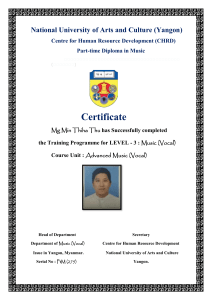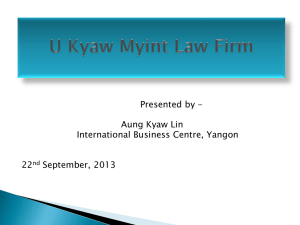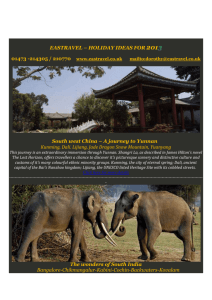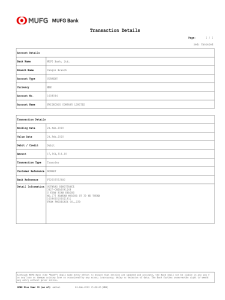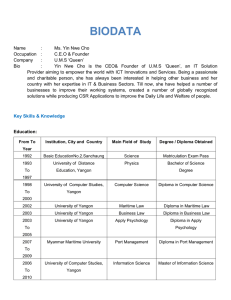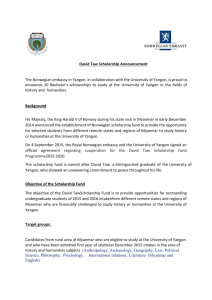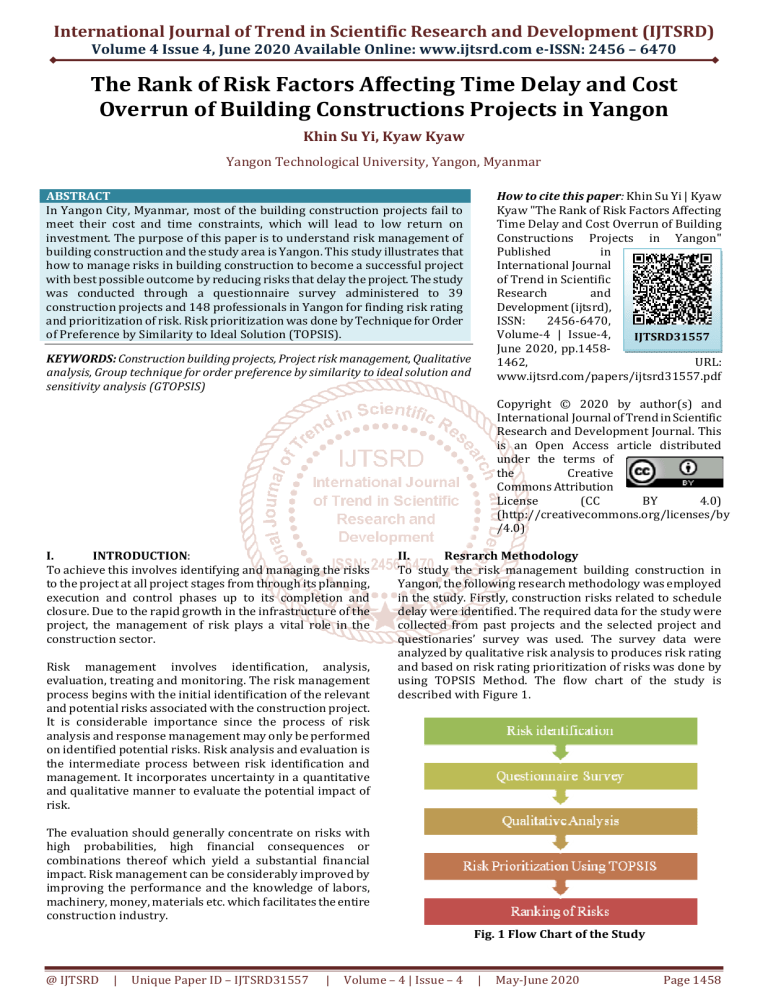
International Journal of Trend in Scientific Research and Development (IJTSRD)
Volume 4 Issue 4, June 2020 Available Online: www.ijtsrd.com e-ISSN: 2456 – 6470
The Rank of Risk Factors Affecting Time Delay and Cost
Overrun of Building Constructions Projects in Yangon
Khin Su Yi, Kyaw Kyaw
Yangon Technological University, Yangon, Myanmar
How to cite this paper: Khin Su Yi | Kyaw
Kyaw "The Rank of Risk Factors Affecting
Time Delay and Cost Overrun of Building
Constructions Projects in Yangon"
Published
in
International Journal
of Trend in Scientific
Research
and
Development (ijtsrd),
ISSN:
2456-6470,
Volume-4 | Issue-4,
IJTSRD31557
June 2020, pp.14581462,
URL:
www.ijtsrd.com/papers/ijtsrd31557.pdf
ABSTRACT
In Yangon City, Myanmar, most of the building construction projects fail to
meet their cost and time constraints, which will lead to low return on
investment. The purpose of this paper is to understand risk management of
building construction and the study area is Yangon. This study illustrates that
how to manage risks in building construction to become a successful project
with best possible outcome by reducing risks that delay the project. The study
was conducted through a questionnaire survey administered to 39
construction projects and 148 professionals in Yangon for finding risk rating
and prioritization of risk. Risk prioritization was done by Technique for Order
of Preference by Similarity to Ideal Solution (TOPSIS).
KEYWORDS: Construction building projects, Project risk management, Qualitative
analysis, Group technique for order preference by similarity to ideal solution and
sensitivity analysis (GTOPSIS)
Copyright © 2020 by author(s) and
International Journal of Trend in Scientific
Research and Development Journal. This
is an Open Access article distributed
under the terms of
the
Creative
Commons Attribution
License
(CC
BY
4.0)
(http://creativecommons.org/licenses/by
/4.0)
I.
INTRODUCTION:
To achieve this involves identifying and managing the risks
to the project at all project stages from through its planning,
execution and control phases up to its completion and
closure. Due to the rapid growth in the infrastructure of the
project, the management of risk plays a vital role in the
construction sector.
Risk management involves identification, analysis,
evaluation, treating and monitoring. The risk management
process begins with the initial identification of the relevant
and potential risks associated with the construction project.
It is considerable importance since the process of risk
analysis and response management may only be performed
on identified potential risks. Risk analysis and evaluation is
the intermediate process between risk identification and
management. It incorporates uncertainty in a quantitative
and qualitative manner to evaluate the potential impact of
risk.
II.
Resrarch Methodology
To study the risk management building construction in
Yangon, the following research methodology was employed
in the study. Firstly, construction risks related to schedule
delay were identified. The required data for the study were
collected from past projects and the selected project and
questionaries’ survey was used. The survey data were
analyzed by qualitative risk analysis to produces risk rating
and based on risk rating prioritization of risks was done by
using TOPSIS Method. The flow chart of the study is
described with Figure 1.
The evaluation should generally concentrate on risks with
high probabilities, high financial consequences or
combinations thereof which yield a substantial financial
impact. Risk management can be considerably improved by
improving the performance and the knowledge of labors,
machinery, money, materials etc. which facilitates the entire
construction industry.
Fig. 1 Flow Chart of the Study
@ IJTSRD
|
Unique Paper ID – IJTSRD31557
|
Volume – 4 | Issue – 4
|
May-June 2020
Page 1458
International Journal of Trend in Scientific Research and Development (IJTSRD) @ www.ijtsrd.com eISSN: 2456-6470
III.
DATA SOURCES
Data collection was carried out using questionnaire survey from building constructions in Yangon, Myanmar. A total of 200
questionnaire sets were distributed and 148 responders were received back. All the responders were having working
experience of 1 year to more than 15 years in carrying out similar buildings projects in Yangon. Risks were identified by
objective and subjective sources. Objective sources are recorded experience from past projects and the current project as it
proceeds. Subjective sources contain experiences based upon knowledgeable experts. To carry out qualitative risk analysis, two
criteria were selected namely,(a) probability of occurrence (b) impact on project duration and cost. Responders were asked to
provide estimate for these criteria which respect to various risks. The data collected were used for prioritization of risk using
GTOPSIS method.
A. Stage of the TOPSIS Method
Step 1: Calculate an evaluation matrix consisting of n alternatives and J attributes with the intersection of each alternative and
attribute given as.
Step 2: Calculate the normalized decision matrix. The normalized value of the alternative with respect to the attribute is
calculated as
x ij
n
r ij =
∑x ij2
i =1
, j = 1, 2, 3, …, J, i = 1, 2, 3,…, n
Step 3: Calculate the weighted normalized decision matrix. Its value:
Vij = w j r ij = w j
x ij
n
∑x
, j = 1, 2, 3, …, J, i = 1, 2, 3,…,n Where is the weight of the attribute, = 1
2
ij
i =1
Step 4: Determine the positive ideal solution and negative ideal solution.
±
±
±
A ± = { v1 , v2 , …, v j } = { max/min vij ׀j ∈ J }
= { max/min ׀j J },j = 1, 2, 3, …, J, i = 1, 2, 3, …, n
Step 5: Calculate the separation measures, using the n-dimension Euclidean distance. The separation of each alternative form
the ideal solution is given as:
Di± =
∑Jj=1 ( vij - v ±j) 2 , j = 1, 2, 3, …, J, i = 1, 2, 3, …,
+
Step 6: Calculate the relative closeness to the ideal solution . The relative closeness of with respect to is defined as: Ci =
Di_
, i = 1, 2, 3, …, n
Di+ + Di_
Step 7: Rank the alternative according to Ci+
IV.
RISK IDENTIFICATION
The 54 number of risks factors which may occur in Yangon are identified and classified design related risks, financial
/economic risks, political risks, management risks, construction risks, environmental risks, technology risks. These risk factors
are shown in the following table 1.
Risk Category
Design
Financial
@ IJTSRD
|
Table1. Risk Factors
Risk Factors
Inadequate design
Non-compliance with design standards
Owner-driected design change request
Defective design by designer
Inadequate and inaccuracies site information
Poor understanding of rules and regulations
Changes in design standards
Inadequate and inaccurate cost estimation
Insufficient funds of client
Delay payment in contract
Contractor cash flow problem
Financial instability of sub-contractor
Community or adjoining business impacts
Prosecution by third party
Price escalation and fluctuation
Interest rate increase
Unique Paper ID – IJTSRD31557
|
Volume – 4 | Issue – 4
|
Code No
D1
D2
D3
D4
D5
D6
D7
F1
F2
F3
F4
F5
F6
F7
F8
F9
May-June 2020
Page 1459
International Journal of Trend in Scientific Research and Development (IJTSRD) @ www.ijtsrd.com eISSN: 2456-6470
Political
Management
Construction
Environmen
-tal risks
Technology Risk
Union Issue
Poor altitude towards foreign companies
Immuaturity of legal system
Lack of transparency
Change in Law
Change in sales tax or other tax structures
Poster actions and Disputes
Pressure from any political party
Failure to provide documents and information
Improper scope of work definition in contract
Poor site management and supervision
Third Party delay
Shortage and delay of machine/material supply
Lack of incentives and motivation
Labor disputes and strikes
Poor planning for safety
Improper construction methods
Defective construction, rework
Coordination with utilities, adjoining neighbors
Earthwork issue
Unskilled labor
Low producity of machine
Changing sequences in construction activity
Scaricity and high prices of man/machine/ material
Poor coordination among subcontractor
Delay in work execution of sub-contractor
Site access, traffic,parking issue
Property damage or theft issue
Change in quantities of work
Accident on sites
Environmental permits and approvals
Archeological findings/unknown burial sites
Hazardous materials or site contaminations
Adverse Weather Condition
Pollution by construction waste
Knowledge on equipments
Service for damaged equipments
Loss of data or software/hardware of computer
P1
P2
P3
P4
P5
P6
P7
P8
M1
M2
M3
M4
M5
M6
M7
M8
C1
C2
C3
C4
C5
C6
C7
C8
C9
C 10
C 11
C 12
C 13
C 14
E1
E2
E3
E4
E5
T1
T2
T3
V.
RESULTS AND DISCUSSION
A. Demographic Result
A total of 200 questionnaire sets were distributed of which 148 valid responses with a rate of 74% were received back.
Respondents who are specialized in building construction were asked to obtain probability and impact of identified 54 risks
identified for construction of buildings Respondents are classified into five groups according to their working fields and their
experiences. They are G1, G2, G3, G4, and G5.G1 is group of construction engineers whose experience is under two years. G2 is
group of construction engineers whose experience is between two to five years. G3 is construction engineers whose experience
is between five to ten years. G4 is construction engineers whose experience is eleven to fifteen years. G5 is construction
engineers whose experience is above fifteen years. The percentage of number of respondents contained in each group is
expressed in the Figure 2.
14%
G5
13%
G4
9%
G3
G2
37%
G1
27%
Fig. 1 Rate of Respondent Based on Working Experience
@ IJTSRD
|
Unique Paper ID – IJTSRD31557
|
Volume – 4 | Issue – 4
|
May-June 2020
Page 1460
International Journal of Trend in Scientific Research and Development (IJTSRD) @ www.ijtsrd.com eISSN: 2456-6470
B. Given Weightages
The classified groups are needed to give weight for TOPSIS Method. The weight given to each group is based on their
experience. The more experience they have, the greater the weight is. Since the total weightage must be equal to one, the
weightage is calculated. The calculated weightage is obtained by the ratio of given weight to each group to total weight. The
calculated weightage is expressed in Table 2.
Group
G1
G2
G3
G4
G5
Table2. Risk Factors
Weightage Given Calculated Weightage
1
0.0667
2
1.333
3
0.2
4
0.2667
5
0.333
C. Ranking Study of Risk Factors by TOPSIS Analysis
The five most important risk factors at building constructions in Yangon are owner directed design change request, poor
planning for safety, poor site management and supervision, unskilled labor and insufficient funds of client. The following table
(3) shows ranking of risk factors results for the building constructions in Yangon, Myanmar by TOPSIS analysis.
Table3. Ranking of Risk factors
Risk Factor
Ci+
Rank
Group
D3
0.514093479
1
Design
M8
0.384881975
2
Management
M3
0.381943669
3
Management
C5
0.32856525
4
Construction
F2
0.331685657
5
Financial
D1
0.293145471
6
Design
C3
0.297091808
7
Construction
D2
0.292120698
8
Design
D5
0.316853076
9
Design
M5
0.254076989
10
Management
D6
0.293413749
11
Design
D7
0.256595557
12
Design
F3
0.254502698
13
Financial
D4
0.247222027
14
Design
C2
0.239271906
15
Construction
C6
0.231156166
16
Construction
M2
0.237015654
17
Management
C1
0.238168325
18
Construction
C9
0.216443912
19
Construction
C 10
0.214217661
20
Construction
E1
0.200863688
21
Environmental
C8
0.193547667
22
Construction
M1
0.185664717
23
Management
C4
0.189574717
24
Construction
F5
0.180052039
25
Financial
E4
0.181772488
26
Environmental
F8
0.178767076
27
Financial
P3
0.181890829
28
Political
P1
0.172523354
29
Political
F1
0.181819748
30
Financial
T3
0.176862263
31
Technology
C 11
0.171489926
32
Construction
M7
0.174155323
33
Management
C 13
0.170439962
34
Construction
C7
0.168469914
35
Construction
F4
0.159769507
36
Financial
M4
0.16211021
37
Management
P2
0.165711123
38
Political
T1
0.159968398
39
Technology
T2
0.151702713
40
Technology
E3
0.154258954
41
Environmental
P5
0.144685605
42
Political
@ IJTSRD
|
Unique Paper ID – IJTSRD31557
|
Volume – 4 | Issue – 4
|
May-June 2020
Page 1461
International Journal of Trend in Scientific Research and Development (IJTSRD) @ www.ijtsrd.com eISSN: 2456-6470
E2
M6
C 14
P4
E5
P6
F7
F6
P8
F9
C 12
P7
0.152144532
0.138955941
0.142585585
0.136255405
0.128850875
0.133188703
0.129056859
0.120560109
0.109246147
0.107681846
0.105623483
43
44
45
46
47
48
49
50
51
52
53
54
Environmental
Management
Construction
Political
Environmental
Political
Financial
Financial
Political
Financial
Construction
Political
Almost these, owner directed design change request is the most dominant factor that is placed at rank 1. It is very important
component in construction project. Therefore, designers should be discussed and explained the customers about design at the
design stage not to delay the constructions.
Poor planning in safety and poor site management and supervision are two major risk factors in management risk group at
rank 2 and 3.
Unskilled labor is the fourth ranked risk factor. Unskilled labor factor impact project time, budget and quality that leads to
project failure.
Cash flow difficulties as the finance risk factor are the fifth most critical risk factor. This can affect the procurement of material
that causing delay in the completion of project within target time. As the recommendation, contractors are urged to have
enough cash to minimize the financial problems.
VI.
CONCLUSION
This study has shown that risk factors are the critical
component in achieving project objectives. The significant
risk-contributing factors found are owner directed design
change request, poor planning for safety, poor site
management and supervision, unskilled labor and
insufficient funds of client. These significant factors are from
four major categories of design, management, construction
and finance group. To minimize the chances of failure of the
construction projects, the significant risk factors should be
properly handled in managing the risk.
ACKNOWLEDGMENT
The author is very grateful to the supervisors and professors
from the Yangon Technological University who guided for
this study. All the personnel in the job site for helping in
achieving information about the procedures and process of
the project are appreciated. My parents who support and
effort are also appreciated.
REFERENCES
[1] Donn E. Hancher, 2003.Civil Engineering Handbook
2nd edition Construction Planning and Scheduling
[2] Muhammad Saiful Islam and Bambang Trigunarsyah.
2017. “Construction Delays in Developing Countries: A
Review.”
[3] Barbara J. Jackson. 2010. “Construction Management
Jump Start.”
[4] Mardhati Zainal Abidin, Risza Rusli and Azmi Mohd
Shariff. 2016. “Technique for Order of Performance by
Similarity to Ideal Solution (TOPSIS) – Entropy
Methodology for Inherent Safety Design Decision
Making Tool.” Procedia Engineering 148 (2016) 1043 –
1050
[5] Robbi Rahim, Andysah Putera Utama Saihaan, Rian
Farta Wijaya and Deffi Sari. 2018. “Technique for Order
of Preference by Similarity to Ideal Solution (TOPSIS)
method for decision support system in top
management.” International Journal of Engineering &
Technology, 7 (3.4) (2018) 290-293
[6] Mardhati Zainal Abidin, Risza Rusli and Azmi Mohd
Shariff. 2016. Nigel J. Smith, Tony Merna, and Paul
Jobling. 2006. “Managing Risk in
Construction
Projects.”
[7] Australian/New Zealand Standard, AS/NZS 4360:2004.
“Risk Management Guideline.”
@ IJTSRD
|
Unique Paper ID – IJTSRD31557
|
Volume – 4 | Issue – 4
|
May-June 2020
Page 1462

